PPC
How To Use Statistics in Digital Marketing

Marketing, traditional or digital, relies mostly on human psychology. As a marketer, you can follow a few fundamental customs that have worked for similar businesses in the past but can never be too sure about its success until it works. It’s especially true in the case of traditional marketing, where a lack of metrics is quite evident.
However, with the rise of analytics, numbers have started to play a major role in the success of digital marketing approaches. For example, now that marketers know email marketing, on average they get a return of $36 for every $1 invested and they can spend a lot more resources on it.
Statistics offer the much-needed support that marketing strategies need to precisely hit the target audience and their pain points. In this article, we’ll discuss the use of statistics in various digital marketing strategies.
1. Use of Statistics in Content Marketing
Content marketing involves producing and distributing content in the form of videos, blogs, and social media posts to stimulate interest in the product or service. Although the objective is to generate sales, content marketing doesn’t explicitly promote the products to the audience.
When you put your first set of content out, a huge engagement and conversion shouldn’t be expected. As you keep uploading content, you start to understand who your ideal audience is and what you can do to refine your approach with content marketing statistics. As a business owner wondering how to grow your business online, closely monitoring the marketing statistics with statistical data analysis methods can help you identify the trends early on, to make the best use of them.
A handy tool for tracking content is Google Analytics. It offers a wide range of metrics including:
- Traffic,
- Bounce rate,
- Average session duration, and
- Demographics.
If your content is indexed, you’ll start seeing numbers on these pages. If an underwhelming output is perceived, you need to tweak your approach to satisfy the needs of your intended audience.
For example, suppose the session duration is lower than expected without it being a fault of the website. In that case, it tells a content marketer that the users aren’t taking the content as valuable and bouncing back sooner than intended. It empowers the marketer to work on it and try something that may work better—like a long-form blog post.
Another use of statistics in content marketing is keyword research. Content is costly, and resources and money are wasted if you don’t put enough effort into researching the keywords that your content may rank on. The search volume, YoY change, and other attributes are factored in while researching for keywords. Depending on the industry and ranking, you can either go with short-tail keywords or longer ones.
2. Use of Statistics in Paid Advertisements
It’s quite challenging to generate leads and gain customers without paid advertisements. Although content marketing strategies are great for long-term returns, they don’t work well to get quick returns as paid ads do. Social media platforms, search engines, and mobile apps are major sources of paid ads.
Statistics and paid ads are linked together to a great extent. Although it may seem like you can get increasing returns by spending more on ads, it’s often not the case. Even if your ads are optimized, it takes in-depth data analytics to generate a satisfactory ROI.
Irrespective of the platform, you need extensive insights to help you optimize your ads. But let’s keep the discussion limited to Google Ads for they are as effective and complex as you would need.
When starting with Google Ads for any business, different marketers take different approaches. But all of them rely on ad statistics. A common strategy is to start with the PPC model. In this model, the marketer takes the necessary keywords and produces ads that run on a pay-per-click billing system. This often results in great engagement and provides the marketer with insights about the ideal customers and demographics. You can tweak your ads depending on these information sets.
Following the success of the PPC campaign, you can either go with the conversion or ROAS model. However, if your target is to generate leads or increase brand awareness, you may go a different way depending on your requirements and industry.
3. Use of Statistics in Social Media Marketing
Social media has become an integral part of marketing campaigns for most B2B and B2C businesses. Although the average conversion rate from social media is quite limited, being free, they’re great for brand awareness campaigns. However, you may need to tweak your approach and content depending on the particular platform.
These constant “tweaks” that you need to implement in your social media marketing rely on statistics. Even though some platforms have more users than others, they may not be the best for your business and industry.
For example, if you’re an HR SaaS provider, you may find better engagement on LinkedIn than on TikTok. On the other hand, if you’re selling cosmetics, Instagram may be the best place. Marketers should determine which platform deserves their time and resources through statistics.
Statistics is also used in social media marketing to determine the ideal customer profile. As social media users are diverse in terms of their interests and demographics, the harvested data from previous post engagements offer a great insight into who might be your best customer. You can build your sales funnel around their demographic, interests, and behavior to maximize the interactions & conversions.
Social media is also great for understanding customer satisfaction, brand loyalty, and feedback. The homogenous data from the platforms allows social media marketers to understand their prospects better and analyze what can be done to improve unfortunate situations.
4. Use of Statistics in Search Engine Optimization
Search engine optimization (SEO) is not only about indexing a page and backlinking. It also revolves around:
- Mobile Optimization
- User experience
- Internal links
- Domain authority
- URLs
- Relevance
- Keywords
- And of course—content!
As a marketer, it’s your responsibility to take care of these elements statistically before engaging in other marketing approaches.
Google search console and Analytics are notably competent tools for this purpose. From providing data about search performances to letting you know about the responsiveness of your website, they make it easier for marketers to leverage statistics to their benefit. They also help you check the website speed and keywords. By following the recommendations provided by the tools, you can rank higher on SERPs. You also can use PageSpeed Insights to get in-depth statistics on the performance and user experience.
5. Use of Statistics in Email Marketing
We already discussed how effective email marketing is in terms of ROI generation. But to get that sort of return, marketers fall back on statistics to a great extent. Moreover, as emails are heavily filtered and neglected by the majority of email clients and users, extensive statistical data analysis methods are essential for them to be nearly as effective. Let’s discuss a few of them:
It’s the most common tracking mechanism for any email marketer. The clickthrough rate (CTR) is calculated by how many recipients have clicked on one or more links in the email. You can use the data to conduct A/B tests and tweak your future emails to engage more customers.
Conversion rate is determined by the percentage of users who complete a specific action after clicking on a link. It could be purchasing a product or filling out a lead generation form. These stats are highly effective in informing marketers about their emails’ viability and conversion rate optimization.
Different from the bounce rate mentioned earlier, the email bounce rate is the percentage of emails that couldn’t be delivered to the recipient’s inbox. It could be a technical issue or a typo, but you must consider removing the hard-bounced emails immediately. Failing to do so can influence your other metrics negatively.
The number of recipients that clicked on the “Share” or “Forward” button present in the box determines the forwarding rate. These tracking measures are mostly used for email newsletters and content. However, you may use it to lure newer inactive prospects into making a sale and reaching hitherto territories.
Although not a reliable stat, unsubscribe rates often allow you to understand how the recipients are reacting to your emails. If you’re getting a lot of unsubscribe requests, you may want to change your email marketing strategy before it does more damage.
FAQ
1. What is the role of statistics in digital marketing?
In marketing, statistics are used to identify market trends, measure and evaluate marketing programs, and assess their effectiveness. In order to be successful in a campaign, it’s important to identify the target market accurately as well as use effective marketing communication channels.
2. What is the best way to analyze data in digital marketing?
Here are some ways to analyze data:
- Site Traffic
- Engagement on social media
- ROAS
- C.T.R
3. How does digital data analysis work?
The purpose of digital analytics is to provide you with a better understanding of what and how users are looking for products and services, and how to enhance your customer experience and strategies by analyzing digital quantitative and qualitative data from all the digital platforms.
4. What happens if I disregard statistics and work on intuition?
If you fully devote yourself to your intuitions by ditching statistics, you may succeed a few times, but you won’t be able to provide results consistently.
5. What are some effective tools to source marketing statistics?
Google Search Console, Google Analytics, Ahrefs, PageSpeed Insights, Google Keyword Planner, etc. are great tools for generating data for marketing purposes.
The Bottom Line
Hopefully, you’ve understood how digital marketers use statistics to their advantage. Possibly, if you have ever been involved in any digital marketing efforts, you’ve used statistics to refine your approaches. Statistics help digital marketers make informed decisions to maximize their strategies.
PPC
Google Ads Benchmarks 2024: New Trends & Insights for Key Industries
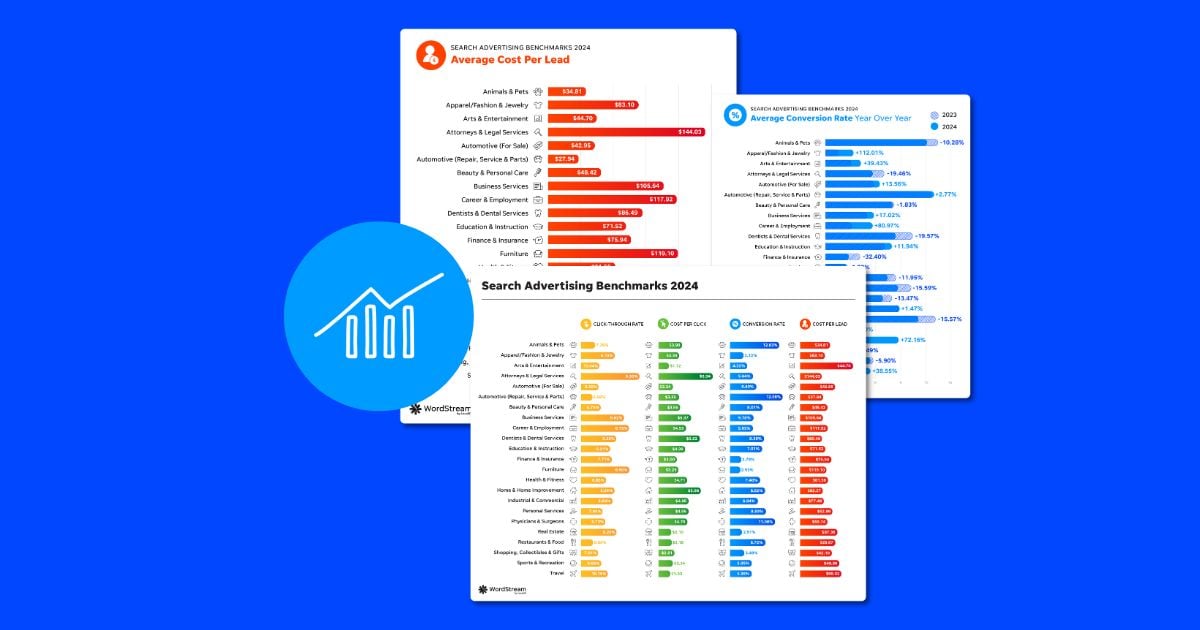
With over 80% of buying journeys beginning on search engines, it’s not a surprise that so many businesses are running search ads to capture searchers and convert them into customers.
But with search engines like Google constantly changing the search landscape, and with advertising costs rising across the board, it’s important to understand how your search ads are really performing to drive the best results for your business.
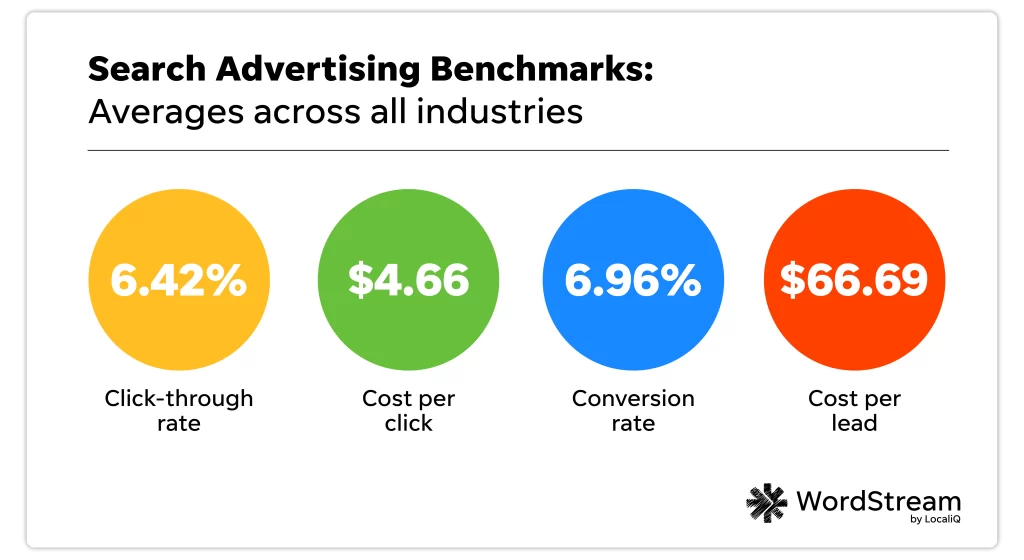
That’s where we come in! We analyzed over 17,000 campaigns running from April 2023 through March 2024 to create the latest version of our search advertising benchmarks report to give you a peek at how businesses in your industry are performing on Google Ads and Microsoft Ads.
We’re also providing expert insights and actionable tips to help you optimize your campaigns and get the best results from your search ads strategy.
🏃 Need to take this data to-go? We wrapped our 2024 Google Ads Benchmarks report into a free, easy-to-download guide here.
Contents
In remembrance of Mark Irvine
Our team was deeply saddened to learn of Mark Irvine’s sudden passing in early May. Mark was a longtime friend and colleague as well as a frequent contributor to the WordStream blog, and the author of our first Google Ads benchmarks report in 2016. Our hearts go out to his friends and loved ones. Find our tribute to Mark here.
Microsoft and Google Ads benchmarks: Key trends in 2024
Before we get into the metric-by-metric details, let’s first get a birds’ eye view of the latest benchmark data.
Here are the overall trends for Google Ads and Microsoft Ads in 2024 you need to know:
- Click-through rate improved for most industries. 70% of industries saw an increase in CTR year over year, some significantly, with an overall average increase of 5% since 2023.
- Cost per click increased for 86% of industries. Some industries, like Real Estate, Sports & Recreation, and Personal Services saw increases of over 25% year over year, with an average overall increase of 10%.
- Conversion rate decreased for 12 out of 23 industries, although the average was fairly minimal at only 1%. Some industries did see bigger decreases, like Finance & Insurance (-32.40) and Dentists & Dental Services (-19.57%). But some industries saw substantial increases YoY, such as Apparel / Fashion & Jewelry (112.01%) and Career & Employment (80.97%).
- Cost per lead increased for 19 out of 23 industries, with an average increase of about 25%. This is a little lower than last year’s 27% increase, which came after record inflation and an unstable economy.
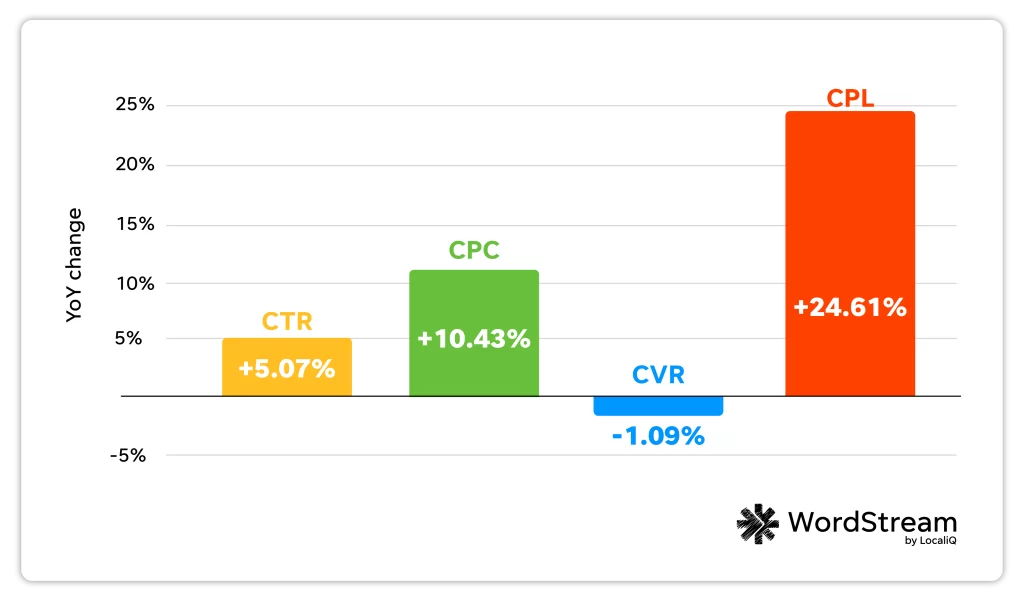

Year over Year Changes in Search Ads Metrics from 2023 to 2024
The overall takeaway from these trends? Increases in CTR indicate that the SERP is becoming more ad-friendly—for many queries, most results above the fold are ads, and ads continue to blend into organic results.


Google has also made broad match the default mode for match types, meaning ads may be matching to searches with relatively low commercial intent. This could lead to increases in clicks that don’t necessarily turn into sales.
The economy also continues to play a role in Google Ads costs increasing. In last year’s Google Ads benchmark report, CPC increased for about 60% of industries, but those increases were fairly small (averaging 2%). This year’s average is 10%, likely due to continued effects from inflation.
“The rise in CPC across most industries aligns with the ongoing economic challenges like inflation,” said Alessandro Colarossi, Partner Data Transformation Lead at Google.
It could also be due to Google increasing costs for their own bottom line. “Google only generates revenue when we click on ads… In 2023 those clicks generated $250B in revenue, up 5x over the last 10 years,” said Andy Crestodina, Co-Founder and CMO at Orbit Media, in this recent article.
🚨 Find out how your business compares to the industry average with our free Google Ads Grader!
Search ads benchmarks for every industry
Ready to dive deeper into some of the latest PPC trends? Here are the Microsoft Ads and Google Ads benchmarks across all metrics and industries for 2024.
Let’s take a closer look with a breakdown for each metric.
📧 Want the full data breakdown straight to your inbox? Download our free 2024 Google Ads benchmarks guide!
Average click-through rate in search ads
Click-through rate, while often overlooked in favor of cost-driven metrics, can be extremely telling when it comes to your search campaign performance. It indicates how frequently people are clicking on your ad once it’s shown in the SERP—which is half the battle when it comes to getting a conversion.
The average click-through rate in Google Ads in 2024 is 6.42%.
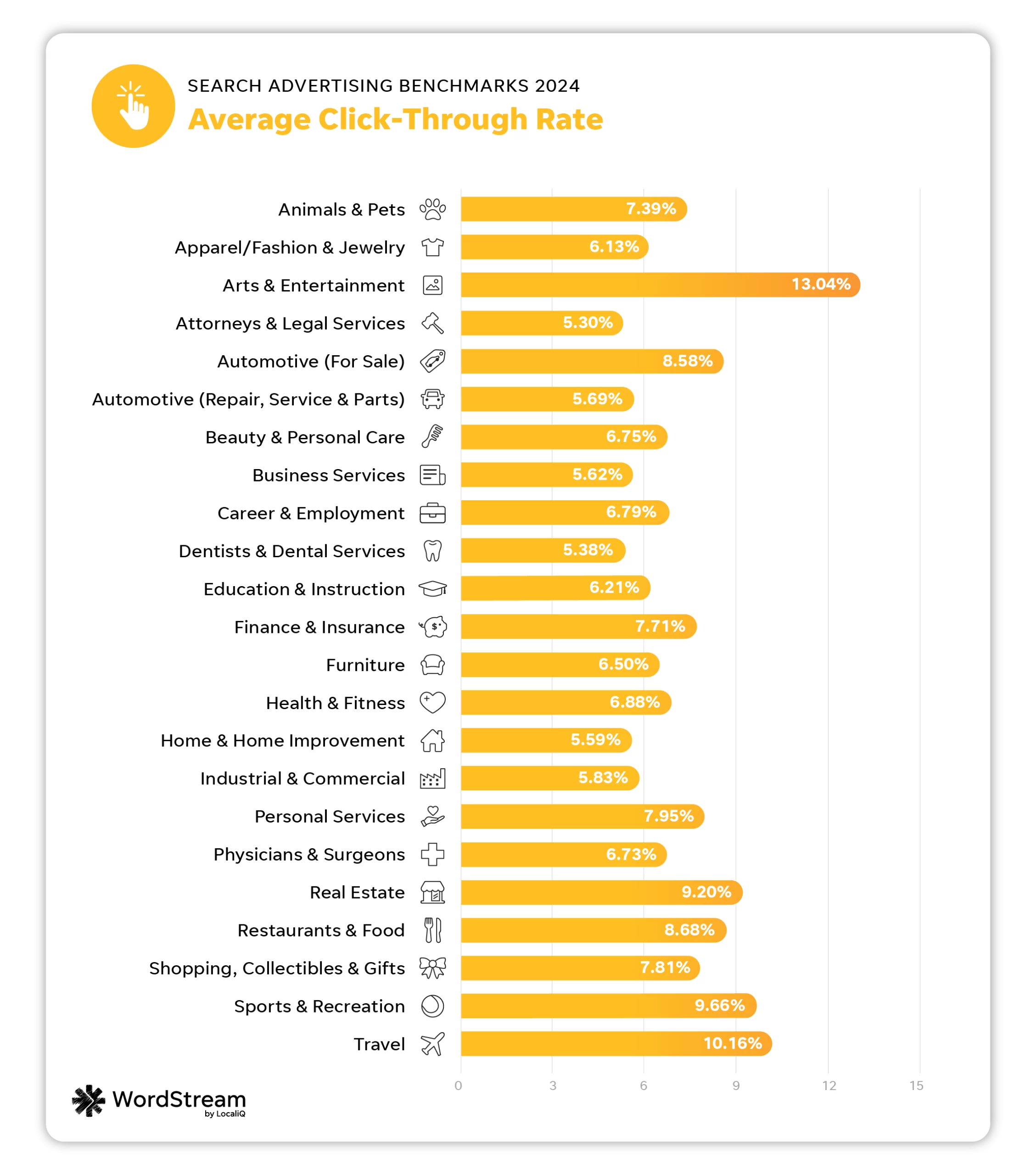

| Business category | Avg. CTR |
| Animals & Pets | 7.39% |
| Apparel / Fashion & Jewelry | 6.13% |
| Arts & Entertainment | 13.04% |
| Attorneys & Legal Services | 5.30% |
| Automotive — For Sale | 8.58% |
| Automotive — Repair, Service & Parts | 5.69% |
| Beauty & Personal Care | 6.75% |
| Business Services | 5.62% |
| Career & Employment | 6.79% |
| Dentists & Dental Services | 5.38% |
| Education & Instruction | 6.21% |
| Finance & Insurance | 7.71% |
| Furniture | 6.50% |
| Health & Fitness | 6.88% |
| Home & Home Improvement | 5.59% |
| Industrial & Commercial | 5.83% |
| Personal Services | 7.95% |
| Physicians & Surgeons | 6.73% |
| Real Estate | 9.20% |
| Restaurants & Food | 8.68% |
| Shopping, Collectibles & Gifts | 7.81% |
| Sports & Recreation | 9.66% |
| Travel | 10.16% |
The industries that saw the best average CTRs this year were Arts and Entertainment (13.04%), Sports and Recreation (9.66%), and Real Estate (9.20%).
Meanwhile, the industries with the lowest average CTRs were Attorneys and Legal Services (5.30%), Home and Home Improvement (5.59%) and Dentists and Dental Services (5.38%).
The overall increase in CTR for most industries indicates a more ad-friendly SERP, which has upsides and downsides. As results above the fold are increasingly populated by ads that blend seamlessly into organic results, advertisers will see an increase in clicks, but they may also see decreases in organic traffic.
“Since the advent of Responsive Search Ads, Google has been subtly shifting away from ads reading as a fixed three-headline format to something more flexible and agile for different screens. Now, you’re seeing ads with one headline that look nearly identical to their organic listings in every way,” said Mark Irvine, Vice President of Search at SearchLab.
Average click-through rate: YoY
The industries that saw the biggest increases in CTR performance year over year were Finance and Insurance (up 24.75%), Shopping, Collectibles, and Gifts (up 22.22%), and Home and Home Improvement (up 16.46%).
In contrast, the industries with the biggest decreases in CTR year over year were Animals and Pets (down 8.99%), Sports and Recreation (down 8.26%) and Apparel, Fashion, and Jewelry (down 5.11%).
The 2024 average CTR of 6.42% is higher than last year’s overall average of 6.11%.


How to improve click-through rate
If your current click-through rate doesn’t align with the average for your industry, you may want to consider how, exactly, your customers are searching for your business and tailor your ads accordingly.
“There are so many avenues now for consumers to find information that before you could only find on a website. You can be cooking dinner and just say ‘Alexa,’ or hit your watch and say ‘Hey, Siri.’ With so many ways for consumers to find search results, you are seeing the competition continue to increase,” said Stephanie Scanlan, Vice President of Client Success at LocaliQ.
Using keywords, headlines, and descriptions optimized for voice search, and answering customer pain points, questions, and more may make your ads more visible (and clickable) in the long run. You can find more ways to improve your click-through rate here.
Average cost per click in search ads
You can’t take your click-through rate into consideration without also factoring in your cost per click. Cost per click is a measure of how much you’re charged, on average, for a click on your search ads. Cost per click can vary depending on your bidding strategy, click-through rates, industry competition, and more.
The average cost per click in Google Ads in 2024 is $4.66.
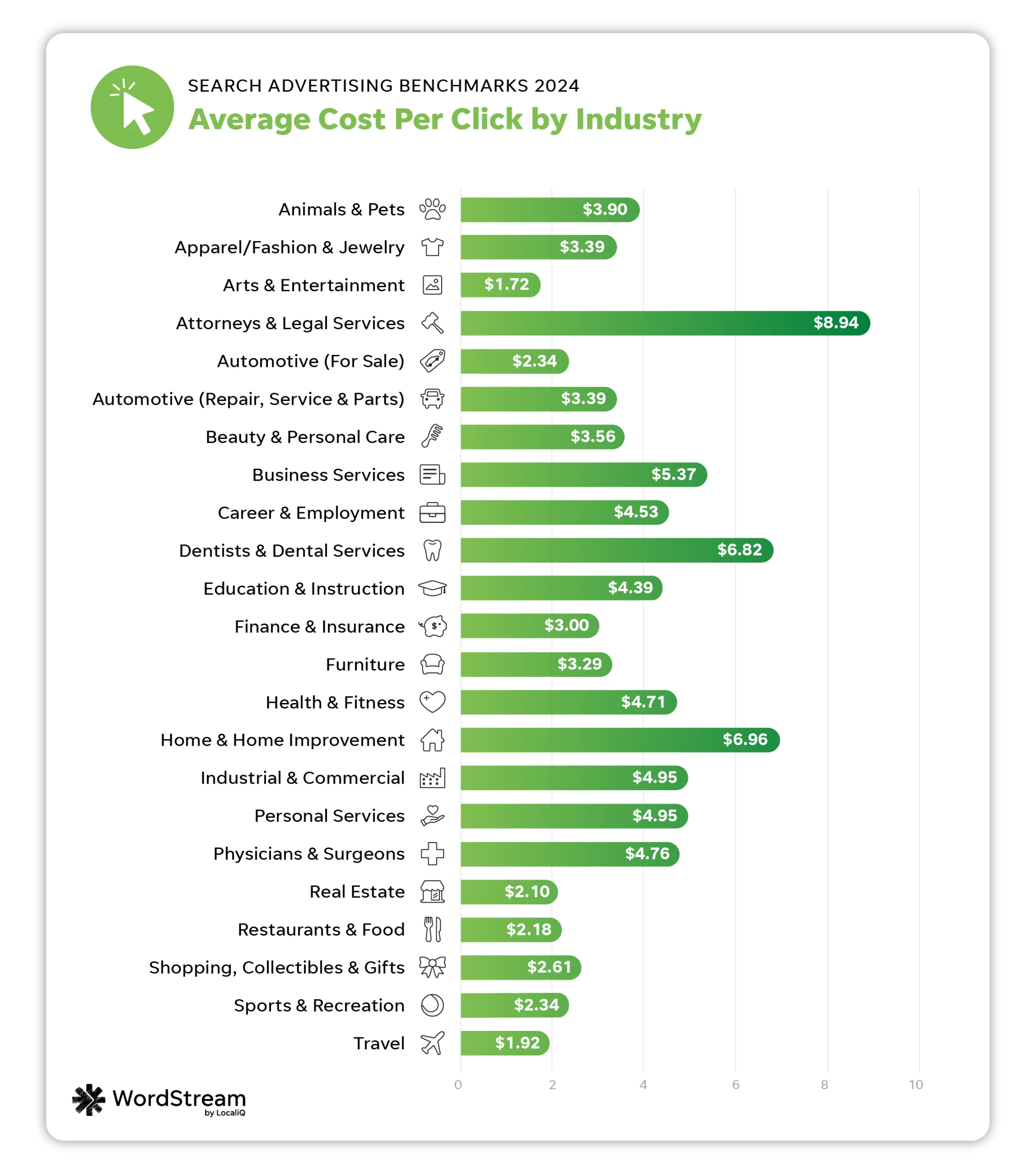

| Business category | Avg. CPC |
| Animals & Pets | $3.90 |
| Apparel / Fashion & Jewelry | $3.39 |
| Arts & Entertainment | $1.72 |
| Attorneys & Legal Services | $8.94 |
| Automotive — For Sale | $2.34 |
| Automotive — Repair, Service & Parts | $3.39 |
| Beauty & Personal Care | $3.56 |
| Business Services | $5.37 |
| Career & Employment | $4.53 |
| Dentists & Dental Services | $6.82 |
| Education & Instruction | $4.39 |
| Finance & Insurance | $3.00 |
| Furniture | $3.29 |
| Health & Fitness | $4.71 |
| Home & Home Improvement | $6.96 |
| Industrial & Commercial | $4.95 |
| Personal Services | $4.95 |
| Physicians & Surgeons | $4.76 |
| Real Estate | $2.10 |
| Restaurants & Food | $2.18 |
| Shopping, Collectibles & Gifts | $2.61 |
| Sports & Recreation | $2.34 |
| Travel | $1.92 |
This year’s industries with the lowest average CPCs were Arts and Entertainment at $1.72, Travel at $1.92, and Real Estate at $2.10.
The industries with the highest average CPCs were Attorneys and Legal Services ($8.94), Home and Home Improvement ($6.96), and Dentists and Dental Services ($6.82).
Last year, CPC increased for about 60% of industries, but those increases were fairly small (averaging 2%). This year’s average increase is 10%. This is likely due to continued effects of inflation; while rates on inflation have slowed, the costs of most goods and services have not come down.
While industries like Attorneys and Legal Services typically face higher costs, conversions from these pricier clicks can be of much higher value for these types of businesses.
It isn’t a shock that some industries are seeing high costs per click, as it was found in the Google Antitrust trial that CPCs have steadily increased over the years.


Average cost per click: YoY
The industries with the biggest drops in CPC performance were Real Estate (increased 35.48%), Sports and Recreation (increased 32.20%), and Personal Services (increased 26.92%).
Meanwhile, the industries that saw the biggest improvements in CPC performance were Finance and Insurance (-25.19%), Attorneys and Legal Services (-2.93%), and Business Services (-1.83%).
This year’s overall average CPC of $4.66 is 44 cents higher than last year’s average of $4.22.


How to lower cost per click
When it comes to any cost in Google Ads, including cost per click, there are a few factors that may be out of your control.
“The noticeable jump in CPC prices could be due to the lingering effects of inflation. Like almost everything else—advertising costs have gone up for businesses, and that is largely contributing to the changes in CPC trends we’re seeing,” said Goran Mirkovic, CMO at Freemius.
“Changes in industry-specific demand (like real estate), competition levels, unique advertising tactics, and consumer behavior could also be impacting these trends. As users interact with search results and ads in new ways, it’s only natural to expect that these changes will have a visible impact in both CTR and CPC rates,” said Goran.
However, there are still optimizations you can make to lower your cost per click. For example, tightly aligning your landing pages with your keyword intent can increase your Quality Score, which in turn can lower your cost per click.
Average conversion rate in search ads
Conversion rate is one of the most important PPC metrics to advertisers because it accounts for how many ad clicks turn into real sales or leads.
It can be tricky to balance trying to achieve a high conversion rate while lowering costs. That’s why it’s so important to closely track your conversion rate against other metrics in your account to get a holistic view of your strategy.
The average conversion rate in Google Ads in 2024 is 6.96%.
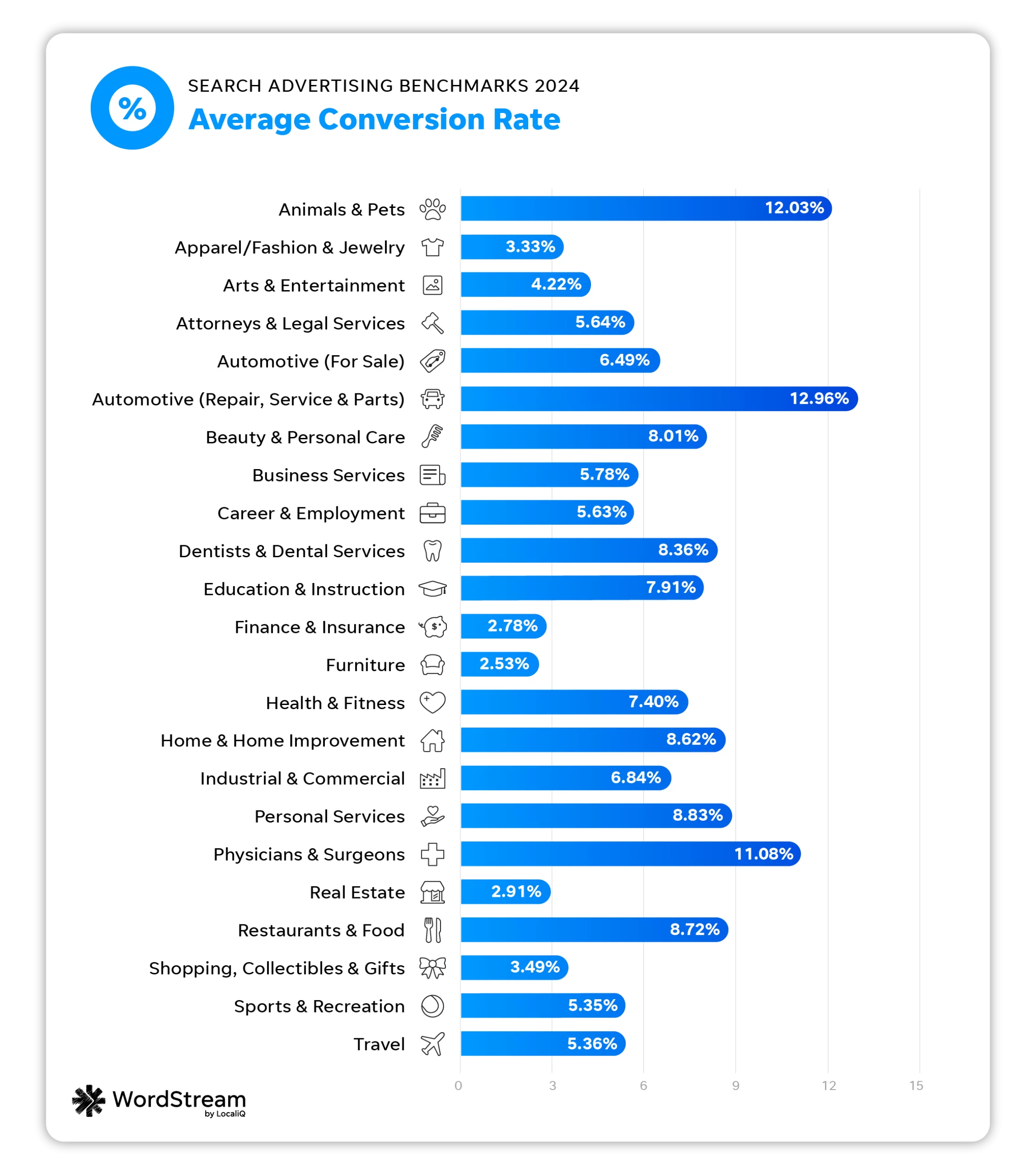

| Business category | Avg. CVR |
| Animals & Pets | 12.03% |
| Apparel / Fashion & Jewelry | 3.33% |
| Arts & Entertainment | 4.22% |
| Attorneys & Legal Services | 5.64% |
| Automotive — For Sale | 6.49% |
| Automotive — Repair, Service & Parts | 12.96% |
| Beauty & Personal Care | 8.01% |
| Business Services | 5.78% |
| Career & Employment | 5.63% |
| Dentists & Dental Services | 8.36% |
| Education & Instruction | 7.91% |
| Finance & Insurance | 2.78% |
| Furniture | 2.53% |
| Health & Fitness | 7.40% |
| Home & Home Improvement | 8.62% |
| Industrial & Commercial | 6.84% |
| Personal Services | 8.83% |
| Physicians & Surgeons | 11.08% |
| Real Estate | 2.91% |
| Restaurants & Food | 8.72% |
| Shopping, Collectibles & Gifts | 3.49% |
| Sports & Recreation | 5.35% |
| Travel | 5.36% |
The industries that had the highest average CVRs were Automotive Repair, Service, and Parts at 12.96%, Animals and Pets at 12.03%, and Physicians and Surgeons at 11.08%.
Industries that saw the lowest average CVRs were Furniture at 2.53%, Finance and Insurance 2.78%, and Real Estate at 2.91%.
As ads are blending into organic results, and often take up more space on the SERP even for search terms with low commercial intent, lower CVRs may be more common. This is because of an increase in clicks from people who may not be ready to convert.
Advertisers have to be really savvy in making the most of their spend and focusing their budget on the highest-intent keywords to maintain strong conversion rates.
Average conversion rate: YoY
The industries with the biggest conversion rate decreases were Finance and Insurance (-32.40%), Dentists and Dental Services (-19.57%), and Attorneys and Legal Services (-19.46%.)
The industries with the highest conversion rate increases were Apparel, Fashion, and Jewelry (112%), Career and Employment (80.97%), and Restaurants and Food (72.16%).
The 2024 overall average conversion rate of 6.96% is only slightly lower than last year’s average of 7.04%.
How to improve conversion rates
When you’re trying to improve your conversion rate, it’s important to first find any correlations between your conversion rate performance and your progress in other PPC metrics.
“All of your different KPIs (key performance indicators) give you a guide to what optimizations need to be made to improve your PPC results,” said Stephanie.
“While cost per conversion, conversion rate, and cost per lead are the indicators to focus most heavily on, a poor CTR or higher-than-needed CPC can also give you insights into a potential problem with your campaign—impacting the overall results. Each KPI should be reviewed both independently and within the bigger picture of overall results to see if they can be optimized to better improve your overall ROI.”
For example, if you find you have a low conversion rate but high CPCs, you should first try to get more clicks at a lower cost, since clicks are half the battle when securing conversions. You can learn more conversion rate optimization tips here.
Average cost per lead in search ads
You could say we saved the best metric in our benchmarks breakdown for last, since most advertisers use cost per lead as their core “money metric.” Cost per lead (also known as cost per conversion, cost per action, or cost per acquisition) determines how much a conversion sourced from a search ad costs your business on average.
The average cost per lead in Google Ads in 2024 is $66.69.
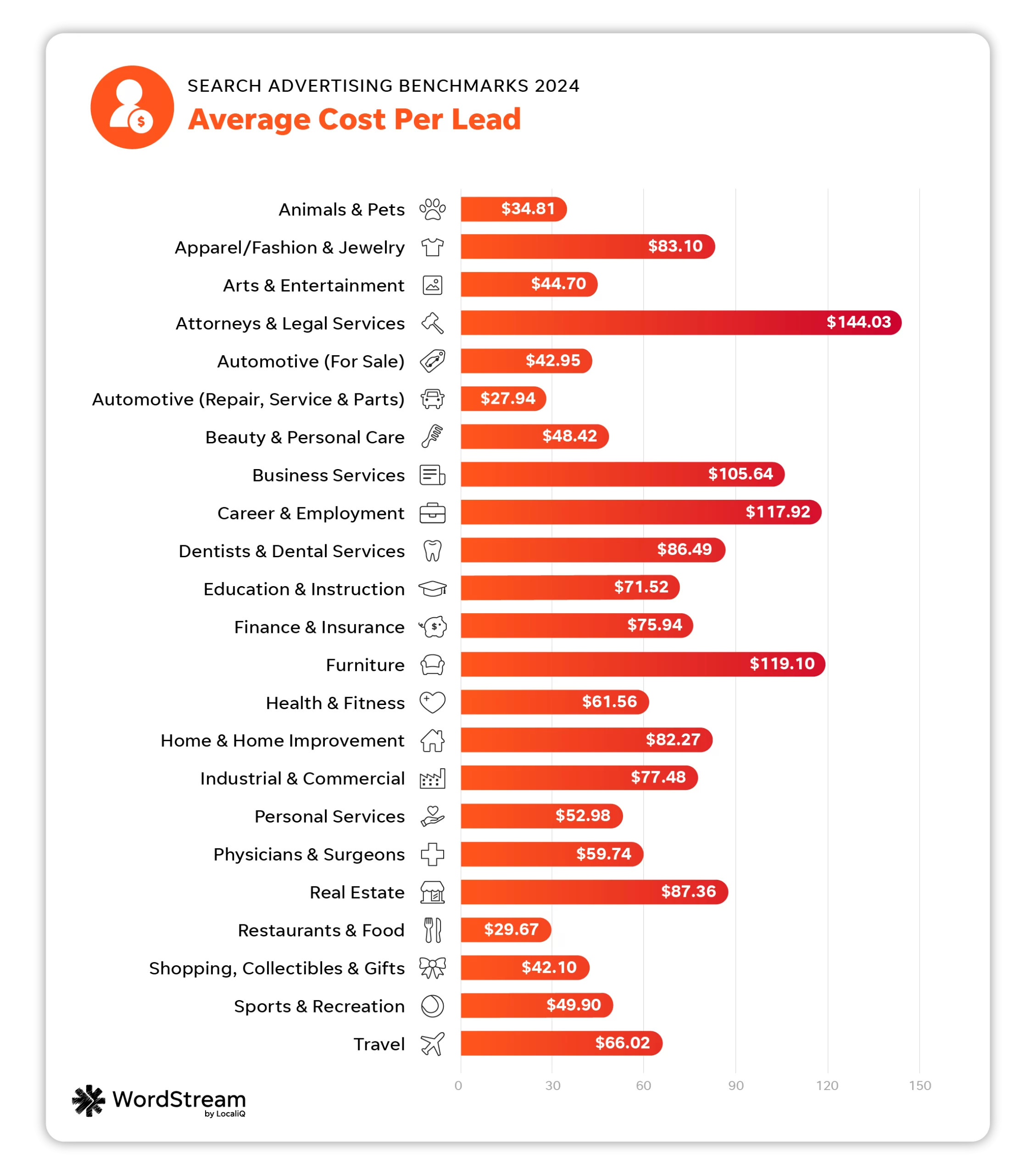

| Business category | Avg. CPL |
| Animals & Pets | $34.81 |
| Apparel / Fashion & Jewelry | $83.10 |
| Arts & Entertainment | $44.70 |
| Attorneys & Legal Services | $144.03 |
| Automotive — For Sale | $42.95 |
| Automotive — Repair, Service & Parts | $27.94 |
| Beauty & Personal Care | $48.42 |
| Business Services | $105.64 |
| Career & Employment | $117.92 |
| Dentists & Dental Services | $86.49 |
| Education & Instruction | $71.52 |
| Finance & Insurance | $75.94 |
| Furniture | $119.10 |
| Health & Fitness | $61.56 |
| Home & Home Improvement | $82.27 |
| Industrial & Commercial | $77.48 |
| Personal Services | $52.98 |
| Physicians & Surgeons | $59.74 |
| Real Estate | $87.36 |
| Restaurants & Food | $29.67 |
| Shopping, Collectibles & Gifts | $42.10 |
| Sports & Recreation | $49.90 |
| Travel | $66.02 |
The industries with the lowest average CPLs were Automotive Repair, Service, and Parts at $27.94, Restaurants and Food at $29.67, and Animals and Pets at $34.81.
Industries with the highest average CPLs included Attorneys and Legal Services ($144.03), Furniture ($119.10), and Career and Employment ($117.92).
In the US versus Google antitrust trial, it was brought to light by the Department of Justice that Google has been increasing advertising costs. This article explains how Google “has the power to raise prices when it desires to do so.”
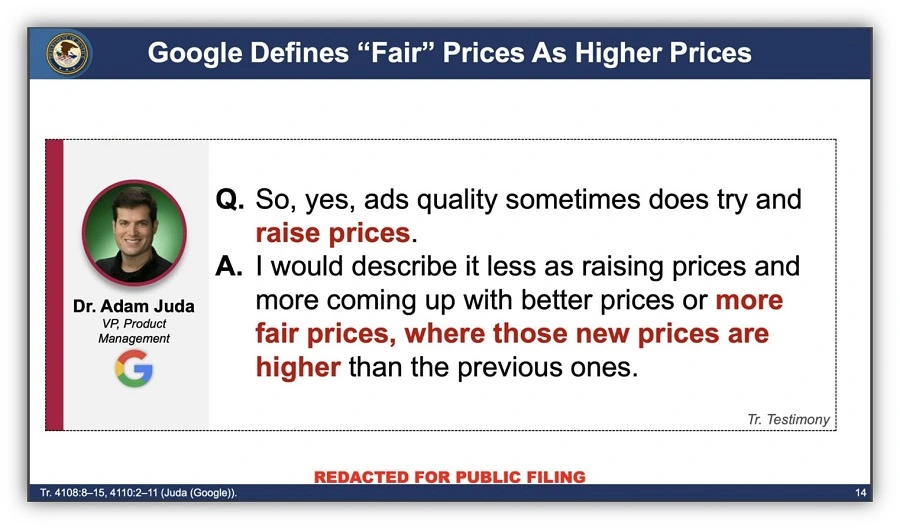

While this could have impacted overall costs for advertisers, it’s important to remember other factors beyond Google’s control (like the number of advertisers in your industry or your chosen account structure) still play a role in your cost per lead. So, if your industry has a higher cost per lead, you can identify ways to combat this—even if, at times, it feels like Google is hiking up prices.
Average cost per lead: YoY
The industries with the biggest improvements in cost per lead were Arts and Entertainment (-41.73%), Finance and Insurance (-15.64%), and Restaurants and Food (-14.77%).
Alternatively, the industries that saw their cost per lead go up year over year were Physicians and Surgeons (58.42%), and Sports and Recreation (56.82%), and Animals and Pets (47.69%).
This year’s overall CPL of $66.69 is $13.17 higher than last year’s average of $53.52.


How to improve cost per lead
While it can be easy to get hung up on how your cost per lead compares to other businesses in your industry, it’s important to focus on what matters to your business’s bottom line and optimize for that.
“This year’s search advertising benchmarks underscore the critical need for campaign optimization. While rising click-through rates suggest a more receptive environment for ads, the cost of clicks increasing, as well as shifts in conversion rates and cost per lead, demonstrate significant variation across industries,” said Katia Hausman, Vice President of Ad Products at LocaliQ.
Keeping in mind that there are some fluctuations and variations when it comes to cost per lead metrics, you may want to see how you can optimize all your campaigns across platforms to bring down your overall cost averages. For example, how you’re attracting and tracking conversions will directly impact your cost per lead numbers.
“This data is actually very surprising—the gains in click-through rate seem to indicate that folks are getting less valuable traffic. Advertisers are doing a great job creating ads to get the user to click, but they may not be able to track the conversions, so cost per lead goes up,” said Navah Hopkins, PPC Evangelist at Optmyzr.
Navah added that there might also be “false positives” within an advertiser’s conversion tracking. This could lead to more low-value actions (such as button clicks) being counted as conversions—skewing conversion numbers to appear higher. Automated bidding strategies would then be thrown off and start to overbid on less valuable ads. This means that businesses need to keep a careful eye on their conversion tracking set-up.
You can uncover more ideas to lower your cost per lead here.
What these search ads benchmarks and trends mean for your business
If you’re wondering how you can take action on these search advertising benchmarks, we’ve got you covered.
1. A holistic approach to your search ad strategy is key
While it can be easy to get preoccupied with individual platform performance, expanding your business’s reach by running ads across multiple search engines is a way to maintain maximum overall marketing ROI.
What to do about it
By running search ads across multiple search engines, including Google and Microsoft, you can maximize your budget and offset potential cost increases.
“As Google Ads CPCs and cost per lead continue to rise, we actually see the reverse in Microsoft Ads. It’s an interesting trend that can help to offset growing costs,” said Katia.


Data from US-based LocaliQ campaigns shows the difference in costs per click between Google and Microsoft.
2. AI and automation can boost results
Automation can help you keep your campaign optimized without sacrificing time or results. You can use automation and AI to simplify budget allocation, keyword management, and overall campaign optimizations.
What to do about it
It may take some trial and error, but look for AI-powered options within the platforms that work for your business; it can save you time and money in the long run.
“Don’t overlook the AI-driven features within Google Ads, such as Performance Max, broad match, and Demand Gen campaigns. These can significantly streamline campaign management and drive results, provided they’re fed with high-quality data,” said Alessandro.
3. Data-driven conversion tracking and first-party data are more important than ever
The upcoming deprecation of third-party cookies has been a hot-button topic within the PPC community for some time now. That said, with the sunset of third-party data fast approaching, it’s more important than ever to collect, organize, and act on your business’s owned, first-party data.
What to do about it
“These benchmarks emphasize the necessity for a data-driven approach to target the appropriate audience and optimize campaigns for conversions across all touchpoints (including websites and landing pages) within today’s competitive advertising landscape. Testing various optimization and bidding strategies continues to be instrumental in maximizing campaign performance,” said Katia.
For example, your conversion tracking strategy should pivot to meet the new tracking capabilities Google has rolled out, like data-driven attribution modeling.
“My top tip for enhancing PPC results revolves around comprehensive conversion tracking and leveraging durable tactics to future-proof your setup. Implementing tools like Enhanced Conversions can provide invaluable insights into campaign performance and audience behavior,” said Alessandro.


4. Some metrics might thrive while others fluctuate
If you feel like your search performance is all over the place, you’re not alone. As Google and Microsoft continue to test and change parts of the search journey, results will fluctuate.
What to do about it
You may need to look at other metrics, like return on ad spend (ROAS), to get a clear picture of your search ad progress.
“ROAS helps you assess the profitability of your advertising efforts by measuring the revenue generated for every dollar spent on ads. It helps a lot with understanding how well a PPC campaign is doing when it comes to driving revenue,” said Goran.
You’ll also need to prioritize some metrics over others depending on your goals.
“Most of our discussions focus on CPL and CVR. There can be all sorts of factors leading to more clicks on ads like the placement, blending into organic results, and bidding strategies optimizing for engagement,” said Michelle Morgan, Co-Founder of Paid Media Pros.
“But the real test of an ad campaign is how much business it actually drives. While we pay attention to all metrics, our bigger efforts are focused on ensuring our campaigns are profitable from a CPL and CVR standpoint.”
So, while you may see a decrease in one metric, try to look out for other growth opportunities within your ad accounts.
A typical ad account could still recover from a poor search performance with the right first-party data.
“I don’t think these metrics should be taken as a sign of doom and gloom. Rather, they represent the reality of the privacy-first world,” said Navah.
“If you’re not able to connect your conversions, and if you’re not able to spend to meet thresholds for modeling, you’ll see the vanity metrics go up (like CTR), while conversion rates and CPL flounder.”
5. Additional optimizations to ad assets are making ads more clickable
Not only are ads being incorporated into new search experiences, they also have the ability to blend in with organic results better than they have in the past—which may be part of the reason for the overall increase in CTR.
What to do about it
Take advantage of the optimization options available for your search advertising campaigns.
“Less than a decade ago, when I first made the WordStream benchmarks, the average CTR was 3.17%, and only one industry had a CTR above 6% (I thought that was an outlier at the time). Now the average is twice that! Ambitious advertisers might be able to realistically achieve double-digit CTRs this year with some creative work,” said Mark.
“We’re seeing Google more aggressively add images to their ads with image assets, Google Business Profile image assets, logo assets, and automating those for new advertisers as well. Not only are the ads becoming more attractive, but Google is also making them look less like ads at the same time.”


6. Google’s Search Generative Experience and Gemini can impact ads
The evolution of Google Ads isn’t just apparent from the advertiser’s perspective, but from the searcher’s perspective as well. For example, Google Gemini and the new Search Generative Experience (SGE) is changing how search results are curated and viewed.
“As SGE became more widely used over the past year and ads have been rolled out in that experience, I think we’re seeing that Google is still in the early stages of optimizing that experience for advertisers. Some of the top areas that Google has boasted its SGE product, like shopping and home improvement, are some of the industries where advertisers have the steepest drops in CTR,” said Mark.
“It’s likely that as people turned to Gemini in 2023 (formerly Bard), users may have seen new ad impressions from their AI chat companions. But unfortunately, those ads may not have been as great a response to their detailed organic responses and had relatively low CTRs when compared to more traditional searches. This growing SGE trend may be artificially dragging down the CTRs from advertisers in these industries,” said Mark.
What to do about it
Continue to evolve your ad copy, keyword intent, and landing pages to be more easily pulled into conversation-style search results. Consider what questions your customers may be looking to get answered by Gemini.
“The uptick in CTR, likely fueled by Google’s evolving SERP design, is also something I’ve seen firsthand. However, the data’s emphasis on the disconnect between higher CTR and lower conversions is interesting. In my view, it highlights the growing importance of proper audience targeting and intent optimization in Google Ads,” said Alessandro.


7. Economic shifts correlate with search ad metric fluctuations in certain industries
You might notice that some industries saw more aggressive year over year changes than others. This is no coincidence, as many external economic factors impact certain verticals more than others.
What to do about it
Take note of your industry’s strengths and weaknesses in the search advertising space. For example, if your industry has slowed during times of economic fluctuation, you may need to rethink how you approach your ads when your customers aren’t ready to buy.
“I think the finance and real estate industries are fascinating in how dramatically you’re seeing them change,” said Mark.
“As it becomes clear that interest rates are likely to stay high for a while and all financial advertisers now have less flexibility in their offers, their ads are becoming less competitive and less attractive from the otherwise bleak news on the SERP. However, at least this industry’s CPC is equally becoming less competitive as these advertisers have less of an edge to outbid each other.”
Meanwhile, real estate is seeing similar issues as the financial market, but real estate ads are struggling less.
“Price and mortgage costs may not be call-outs in their ads, but location, features, and new opportunities are much easier to attract clicks on the SERP, so their ads are still performing strong enough to maintain their CTR (and possibly CVR). This justifies for real estate businesses to increase their budgets to remain competitive in an industry that’s struggling offline,” said Mark.
8. Regular PPC audits are more important than ever
If there is one final takeaway from our 2024 Google Ads industry benchmarks report, it’s that staying on top of your account performance this year is critical as industry averages continue to fluctuate year over year.
What to do about it
Try scheduling regular PPC audits to see how your PPC metrics are pacing against the benchmarks in your industry.
“By regularly analyzing and refining keywords, ad copy, targeting, and bidding strategies—businesses can ensure that their ads are reaching the right audience and generating the best possible results.
In marketing and advertising, staying proactive and making data-driven adjustments is what gets rewarded,” said Goran.
Take action on these search advertising benchmarks
When it’s time to measure your PPC performance, and you’re not sure where to start, these benchmarks can be a guiding light. However, try to remember that no two Google Ads accounts are the same. What might work for one advertiser may not work for another. So, keep in mind that there is no right or wrong answer for how you approach your PPC strategy.
That said, using data like the averages in this report can help you make informed decisions about your marketing and advertising. The sooner you start to track and pivot your ad strategy, the better! Plus, if you find you still want more out of your PPC ads as you start optimizing your account, our solutions are here to help you make the most out of your search campaigns.
About the data
This report is based on a sample of 17,998 US-based search advertising campaigns running between Apr 1, 2023, and March 31, 2024. Our proprietary platform dynamically shifts budget between search channels on a campaign-by-campaign basis, but in aggregate, 80-85% of spend was allotted to Google Ads and 15-20% to Microsoft Ads. Each subcategory includes at minimum 70 unique active campaigns. “Averages” are technically median figures to account for outliers. All currency values are posted in USD.
PPC
The Ultimate Guide to Click Fraud

Click fraud involves deceptive practices that affect campaign integrity and efficiency of digital marketing campaigns. It presents a significant challenge to online advertisers.
Click fraud occurs when an individual, script, or program maliciously clicks on an online advertisement without any genuine interest in the offer behind the click.
This deceptive practice drains advertising budgets and skews marketing data.
At its core, click fraud is an attempt to simulate the appearance of interest in an advertisement.
This can be done for various reasons. They include draining a competitor’s advertising budget or earning undue revenue from pay-per-click (PPC) agreements.
Unlike legitimate clicks that reflect genuine interest, clicks generated through fraud provide no real value to advertisers.
Types of Click Fraud
Understanding the different mechanisms through which click fraud can be perpetrated is crucial for its detection and prevention. The most common types include:
- Bot Clicks: Automated programs, known as bots, mimic human behavior to click on ads. These bots can operate at a massive scale, generating vast amounts of fraudulent traffic.
- Competitor Clicks: In some cases, competitors may engage in clicking on ads maliciously to deplete the advertising budgets of their rivals, thereby hampering their ability to compete effectively.
- Click Farms: Groups of individuals are hired to manually click on advertisements. These click farms can be found across the globe. They are often used to generate fake clicks at a scale that automated systems can detect.
Bot Clicks
Bot clicks represent one of the most sophisticated and challenging forms of click fraud facing online advertisers today.
These automated programs are designed to mimic human behavior, interacting with digital ads as if they were genuine users.
The sophistication of such bots varies significantly; some operate on a basic level, randomly clicking on ads across the web. Others are highly advanced, capable of mimicking human browsing patterns, completing forms. They can even bypass security measures designed to differentiate between human and non-human traffic.
How Bot Clicks Operate
Bot clicks are generated through automated scripts or software programs. These bots can be distributed across numerous devices and networks. This makEs their traffic appear to originate from different locations and IP addresses.
This distribution helps to mask the fraudulent activity, complicating detection efforts.
Advanced bots further disguise their nature by emulating human interaction times, mouse movements, and even engaging in “random” non-linear browsing behaviors to evade pattern recognition systems.
Scale of Operation
The scale at which bots can operate is a significant part of what makes them such a formidable challenge.
A single botnet, which is a network of infected computers controlled by a hacker, can generate millions of clicks without any direct human involvement.
This capability allows fraudsters to inflict substantial financial damage on targeted advertising campaigns within a very short timeframe.
Impact on Advertisers
The impact of bot clicks on advertisers is multifaceted:
- Financial Loss: The most immediate effect is financial. Advertisers pay for clicks, assuming they represent genuine interest. Bot clicks drain budgets without providing any return on investment.
- Skewed Analytics: Bots inflate engagement metrics, leading advertisers to make misinformed decisions about the effectiveness of their campaigns. This distortion can misguide marketing strategies, budget allocation, and performance assessment.
- Deterioration of Advertiser-Publisher Trust: Over time, unchecked bot traffic can erode the trust between advertisers and publishers. Advertisers may become skeptical of the traffic quality provided by certain platforms, impacting future advertising relationships and negotiations.
Combating Bot Clicks
Efforts to combat bot clicks involve a combination of technology, vigilance, and collaboration:
- Advanced Detection Tools: Sophisticated detection tools analyze click patterns, verify IP addresses, and monitor user behavior to help identify and filter out bot traffic.
- Machine Learning and AI: Machine learning algorithms and AI can enhance the ability to detect anomalies in traffic that suggest bot activity, continually improving detection accuracy over time.
- Industry Collaboration: Sharing information about known bots and attack patterns within the industry can help advertisers and platforms stay one step ahead of fraudsters.
Understanding the nature and operation of bot clicks is essential for advertisers seeking to protect their investments.
Competitor Clicks
Competitor clicks refer to a deliberate and malicious practice where businesses click on their rivals’ online advertisements.
This form of click fraud is driven by the desire to undermine a competitor’s marketing efforts, draining budgets and thus making it more difficult for them to maintain a visible online presence.
As well as financial strain, the behaviour can produce inaccurate data. This can lead advertisers to change their campaigns in ways they otherwise wouldn’t if the information was honest.
Unlike bot-generated clicks, competitor clicks involve direct human action. This can make them challenging to identify due to their seemingly legitimate nature.
This tactic can be particularly appealing in highly competitive industries where advertising costs are high, and market share is fiercely contested.
Strategies for Mitigation
Addressing competitor clicks requires a multifaceted approach that combines vigilance, technological solutions, and potentially legal action:
- Monitoring and Analysis: Regularly monitoring ad performance and analyzing traffic sources for irregularities can help identify suspicious patterns indicative of competitor clicks.
- Geo-targeting and Ad Scheduling: Limiting ads to specific geographic locations or times can help avoid exposure to competitors, reducing the likelihood of fraudulent clicks.
- Legal Recourse: In some jurisdictions, engaging in click fraud can have legal consequences. If competitor clicks can be conclusively traced back to a source, legal action may be a viable option.
- Engagement with Ad Platforms: Many advertising platforms have mechanisms in place to identify and refund fraudulent clicks. Maintaining open communication with these platforms can help ensure that you’re not paying for illegitimate traffic.
Understanding the dynamics of competitor clicks is crucial for any business reliant on online advertising. By employing targeted strategies to mitigate their impact, businesses can protect their advertising investments.
Click Farms
Click farms represent a more human-centric approach to generating fraudulent clicks on digital advertisements in comparison to Bot Clicks.
These operations consist of networks of individuals who are paid to manually click on ads, visit websites, and even interact with content to feign genuine user engagement.
Unlike bots click farms use human labor to produce clicks and interactions. This makes it harder for algorithms to distinguish them from legitimate traffic.
As well as the effects associated with bots and competitors, clickfarms can be harmful to an advertiser’s reputation. Platforms and consumers may begin to associate certain brands with low-quality traffic, potentially damaging reputations over time.
Operation and Global Presence
Click farms operate in a relatively straightforward manner: individuals are recruited and organized into groups, often in low-wage countries, to click on specified advertisements or interact with digital content for hours at a time.
These operations can range from small setups with a handful of individuals to large-scale operations employing hundreds or even thousands of people.
The global presence of click farms is widespread.
The decentralized nature of click farms, coupled with the use of VPNs and proxy servers to mask the real geographical location of the clicks, complicates the task of tracing and addressing this form of click fraud.
Challenges in Detection and Prevention
Detecting click farm activity poses a significant challenge due to the human element involved. However, some strategies can be employed to mitigate their impact:
- Pattern Recognition: Advanced analytics and machine learning tools can help identify patterns typical of click farms, such as unnatural spikes in traffic or clicks coming from geographical locations not matching the target audience.
- Strengthened Ad Network Policies: Ad networks continuously improve their policies and detection mechanisms to identify and penalize advertisers or publishers involved in click farm activities.
- Selective Targeting and Engagement: By carefully choosing where and when ads are displayed, and by closely monitoring engagement patterns, advertisers can reduce their exposure to click farms. This might include avoiding advertising in regions known for click farm operations or adjusting bids based on the quality of traffic received.
Mitigating the Risk
To mitigate the risk of click farm fraud, advertisers must remain vigilant, employing a combination of technology and best practices to identify and reduce fake clicks. This includes regularly auditing traffic sources, implementing more stringent targeting criteria, and working closely with ad platforms to report and address suspicious activities.
Importance of Understanding Click Fraud for Businesses and Advertisers
For businesses and advertisers, the ramifications of click fraud extend beyond just wasted financial resources.
It can lead to misguided decisions based on distorted data, misallocation of marketing budgets, and diminished campaign performance.
Understanding click fraud in all its forms and nuances is the first step in developing effective strategies to combat it. This knowledge not only aids in safeguarding advertising investments but also ensures the integrity of marketing campaigns, allowing for genuine engagement with potential customers.
In a time when digital visibility is crucial for market success, safeguarding against fraudulent activities is essential.
Notable Click Fraud Operations
1. Methbot Operation
- Overview: Methbot was one of the largest and most sophisticated ad fraud schemes ever uncovered, primarily active around 2015-2016. It was operated by a Russian cybercriminal group and named after its key software, “Methbot.”
- Method: The operation used an extensive network of bots, running on over half a million fake web pages that mimicked the sites of legitimate publishers. These bots simulated human behavior to view video ads, generating fraudulent ad views on a massive scale.
- Impact: Methbot generated upwards of $3 to $5 million in fraudulent ad revenue per day, according to some estimates. Its sophistication and scale highlighted the vulnerabilities in digital ad ecosystems and the need for advanced detection and prevention strategies.
2. 3ve Operation
- Overview: Uncovered in 2018, 3ve was another extensive digital ad fraud operation. It combined three separate campaigns, hence the name 3ve (pronounced “Eve”), and involved over 1 million compromised IP addresses.
- Method: This operation used a mix of techniques, including infecting users’ computers with malware to create a botnet for generating fraudulent ad views and clicks, as well as creating fake websites to host ads and utilizing spoofed IP addresses to simulate geographically relevant traffic.
- Impact: 3ve affected thousands of advertisers and siphoned off millions of dollars before it was taken down through a coordinated effort by Google, White Ops (now HUMAN Security), and various law enforcement agencies. The operation led to several arrests and highlighted the importance of cross-industry collaboration in combating ad fraud.
3. ZeroAccess Botnet
- Overview: ZeroAccess was a prominent botnet that, at its peak, affected millions of computers worldwide. It was primarily used for click fraud and Bitcoin mining.
- Method: The botnet infected computers through various vectors, turning them into bots that executed click fraud on a massive scale, alongside other malicious activities. ZeroAccess used sophisticated methods to avoid detection and removal, making it one of the more resilient threats at the time.
- Impact: The financial damage caused by ZeroAccess in terms of wasted advertising spend and bandwidth consumption was significant, running into millions of dollars. Efforts by companies like Microsoft and law enforcement led to a partial takedown of the botnet, underscoring the challenges of eradicating such distributed threats.
These case studies exemplify the diversity of click fraud operations, from botnets and malware to sophisticated ad fraud schemes.
Detecting Click Fraud
Detecting click fraud is a critical component of digital advertising security, ensuring that budgets are spent efficiently and that campaign data reflects genuine user engagement.
Identifying fraudulent activity requires a combination of vigilant monitoring, sophisticated tools, and an understanding of traffic and click pattern irregularities.
Indicators of Click Fraud
Several key indicators can signal the presence of click fraud in digital advertising campaigns:
- Abnormally High Click-Through Rates (CTR): While a high CTR is generally positive, an unexpected or unexplained surge can be indicative of fraudulent activity.
- Short Duration Visits: If analytics show a significant portion of clicks result in very brief site visits, often seconds, this may suggest non-genuine interaction.
- High Bounce Rates: Similar to short-duration visits, a high bounce rate with a correspondingly high CTR might indicate fraudulent clicks.
- Geographic Inconsistencies: Receiving clicks from regions not targeted by your campaign or from locations known for click farms can be suspicious.
- Irregular Times of Activity: A sudden influx of clicks during off-peak hours, especially in patterns not consistent with your typical traffic, could suggest fraud.
Tools and Technologies for Detection
A variety of tools and technologies are available to help detect and mitigate click fraud:
- Automated Detection Software: Many platforms offer built-in fraud detection features. Additionally, third-party software can provide an extra layer of protection by analyzing traffic and identifying potential fraud.
- AI and Machine Learning: Advanced solutions utilize artificial intelligence and machine learning algorithms to recognize patterns and behaviors indicative of click fraud. These systems can adapt over time, improving their detection capabilities.
- Traffic Analysis Tools: Tools that offer deep insights into traffic sources, behavior patterns, and engagement metrics can help advertisers identify inconsistencies that may signal fraud.
Analyzing Traffic and Click Patterns for Irregularities
Effective detection of click fraud involves a detailed analysis of traffic and click patterns, looking for anomalies and irregularities:
- Benchmarking Normal Traffic Patterns: Establishing a baseline for normal traffic and engagement patterns allows for easier identification of anomalies. This includes understanding typical user behavior, average session durations, and normal CTRs for your campaigns.
- Segmentation Analysis: Breaking down traffic by variables such as device type, geographic location, and time of day can help isolate suspicious activity. For example, an excessive number of clicks from a single device type or location might indicate fraud.
- Looking for Patterns in IP Addresses: Repeated clicks from the same IP addresses, especially in short successions, can be a strong indicator of fraudulent activity. IP analysis can also reveal the use of VPNs and proxies commonly used by click farms and bots.
Impact of Click Fraud
The impact of click fraud extends beyond immediate financial losses, affecting the broader integrity of online advertising ecosystems, skewing campaign data, and influencing marketing strategies. Understanding the multifaceted consequences of click fraud is essential for businesses seeking to navigate the digital advertising landscape effectively.
Long-term Consequences for Online Advertising Ecosystems
The pervasive issue of click fraud poses significant threats to the sustainability and trustworthiness of online advertising ecosystems:
- Decreased Advertiser Confidence: As advertisers become more aware of the prevalence of click fraud, their confidence in digital advertising platforms may wane. This decreased trust can lead to reduced advertising spend and a search for alternative marketing channels.
- Inflation of Advertising Costs: To compensate for losses due to fraud, platforms may increase the cost of advertising, further straining advertiser budgets and exacerbating the challenge of achieving a positive return on investment.
- Innovation and Regulation: While the challenge of click fraud spurs innovation in detection and prevention technologies, it also calls for more stringent regulations and standards within the industry. This evolving landscape can both offer new opportunities and impose additional burdens on advertisers and platforms alike.
Preventing Click Fraud
Preventing click fraud is essential for maintaining the integrity of digital advertising efforts and ensuring that marketing budgets are spent effectively.
Through a combination of best practices, proactive fraud detection measures, and strategic platform selection, advertisers can significantly reduce their exposure to fraudulent activities.
Best Practices for Advertisers and Marketers
- Educate Your Team: Awareness is the first step in prevention. Ensure your marketing team understands what click fraud is, how it can impact your campaigns, and the common signs of fraudulent activity.
- Use Anti-Fraud Technologies: Invest in reputable anti-fraud technologies and services that specialize in detecting and mitigating click fraud. These tools can provide an additional layer of protection by analyzing traffic in real-time and flagging suspicious activities.
- Implement Strict Targeting: Narrow your ad campaigns’ targeting to focus on demographics and geographies that are most relevant to your business. This approach not only improves campaign effectiveness but also reduces the likelihood of attracting fraudulent clicks.
Setting Up Fraud Detection Measures
- Enable Click Fraud Monitoring: Many ad platforms offer monitoring tools that can be enabled to track the behavior of clicks and detect patterns indicative of fraud.
- Analyze Traffic Regularly: Conduct regular analyses of your traffic data for abnormalities such as spikes in traffic from specific regions or devices, short session durations, and unusually high bounce rates.
- Use CAPTCHAs and IP Blocking: Implement CAPTCHAs for interactive elements of your campaigns to deter bots, and use IP blocking to exclude traffic from known fraudulent sources.
Choosing the Right Platforms and Ad Networks
- Research and Select Trusted Platforms: Opt for advertising platforms and networks with robust anti-fraud measures and positive reputations for managing click fraud. Platforms that are transparent about their efforts to combat fraud are generally more reliable.
- Demand Transparency: Work with platforms that provide detailed reporting and analytics tools, allowing you to see where your ads are being placed and how they are performing.
How Do I Get Rid of Click Fraud?
Immediate Steps to Take When You Detect Click Fraud
- Pause Your Campaigns: Temporarily pausing affected campaigns can prevent further loss until the source of fraud is identified and addressed.
- Report to Ad Platforms: Immediately report the suspected fraud to your ad platform. Provide them with detailed evidence of the suspicious activity to support your claim.
Working with Ad Platforms for Refunds and Blocking Fraudulent Sources
- Request Refunds: Many ad platforms have procedures in place for investigating click fraud claims and issuing refunds for fraudulent clicks. Be prepared to provide detailed data to support your refund request.
- Collaborate on Prevention: Work closely with ad platforms to identify and block fraudulent sources. This collaboration can lead to the development of customized solutions to protect your specific campaigns.
Continuous Monitoring and Adjustment Strategies
- Regularly Review Campaign Performance: Continuously monitor your campaign performance for signs of click fraud. Adjust your strategies based on insights gathered from your ongoing analysis.
- Stay Updated on Trends: Click fraud tactics evolve, so staying informed about the latest trends in fraud and prevention measures is crucial. Regularly updating your knowledge and tools can provide ongoing protection for your campaigns.
Preventing click fraud requires a proactive, informed approach. By implementing these best practices and remaining vigilant against new threats, advertisers can better protect their investments and ensure the integrity of their online marketing efforts.
Legal and Ethical Considerations
The issue of click fraud brings to the forefront significant legal and ethical considerations within the digital advertising industry. Understanding the legal landscape, ethical implications, and available recourse can empower businesses to navigate these challenges more effectively.
Is Click Fraud Legal?
Click fraud is considered illegal under various laws that prohibit fraudulent activities and cybercrime. However, the specific legal classification and penalties associated with click fraud can vary significantly by jurisdiction.
At its core, click fraud involves deception and financial harm, aspects that are generally actionable under laws related to fraud, computer misuse, and unfair competition.
Overview of Laws and Regulations Against Click Fraud
- Computer Fraud and Abuse Act (CFAA) in the U.S.: This federal statute is one tool used to combat click fraud, addressing unauthorized access or use of computer systems, which can include the deployment of bots for fraudulent clicking.
- Wire Fraud Statutes: In many jurisdictions, click fraud can be prosecuted under general wire fraud statutes, given that it involves the use of telecommunications or the internet to carry out fraudulent schemes.
- Consumer Protection Laws: Laws aimed at protecting consumers from deceptive practices may also be applied to click fraud, particularly when false advertising or misrepresentation is involved.
The complexity of digital advertising ecosystems and the transnational nature of the internet can complicate legal actions against click fraud, highlighting the need for international cooperation and specific cybercrime legislation.
Ethical Considerations in Digital Advertising
Beyond legality, click fraud raises ethical concerns that can undermine trust in digital ecosystems:
- Transparency: Advertisers and platforms have a duty to ensure transparency in how clicks are generated and accounted for. Concealing or ignoring fraudulent activities can erode trust among all stakeholders.
- Fair Competition: Click fraud distorts competition by unfairly depleting competitors’ advertising budgets, violating principles of fair play.
- Consumer Trust: Engaging in or tolerating click fraud can diminish consumer trust in digital advertisements, affecting the credibility of online marketing channels.
Adhering to ethical standards is crucial for maintaining the integrity and sustainability of digital advertising.
Future of Click Fraud
As digital advertising continues to evolve, so do the methods and tactics of click fraud.
Understanding emerging trends, the role of advanced technologies in combating this fraud, and making informed predictions about the future of online advertising are crucial for staying ahead in this ongoing battle.
Emerging Trends and Technologies
The landscape of click fraud is constantly shifting, with fraudsters regularly adopting new technologies to carry out their schemes. Some emerging trends include:
- Sophisticated Botnets: As bot detection techniques become more advanced, so too do the botnets. These networks are increasingly mimicking human behavior more accurately, making them harder to detect.
- Machine Learning for Fraud Creation: Just as defenders use machine learning to detect fraud, attackers are beginning to use these technologies to learn and adapt to new detection methods, creating a cat-and-mouse dynamic.
- Cross-Platform Fraud: Fraudulent activities are spreading across platforms, from traditional web-based advertising to mobile apps and social media platforms, exploiting the integrated nature of digital ecosystems.
The Role of AI and Machine Learning in Combating Click Fraud
Artificial Intelligence (AI) and Machine Learning (ML) are at the forefront of the fight against click fraud, offering powerful tools to identify and mitigate fraudulent activities:
- Pattern Recognition: AI/ML algorithms excel at detecting patterns and anomalies in data, including subtle signs of fraud that might elude human analysts.
- Predictive Analytics: These technologies can predict potential fraudulent activities by analyzing historical data and identifying risk factors associated with click fraud.
- Real-Time Monitoring and Response: AI systems can monitor campaign data in real-time, providing immediate responses to suspected fraud, thereby minimizing potential losses.
Predictions for the Online Advertising Industry
The future of click fraud and its impact on the online advertising industry hinge on several factors, including technological advancements, regulatory changes, and shifts in advertiser strategies:
- Increased Investment in Fraud Detection: Businesses are likely to allocate more resources toward advanced fraud detection solutions as the cost of click fraud becomes increasingly untenable.
- Greater Collaboration Among Stakeholders: There may be an uptick in collaboration between advertisers, platforms, and regulatory bodies to establish industry-wide standards and share intelligence on fraudulent activities.
- Regulatory and Legal Evolution: New laws and regulations specifically addressing online fraud and digital advertising practices are expected to emerge, providing clearer frameworks for combatting click fraud.
- Shift Toward Quality Over Quantity: Advertisers might prioritize metrics that reflect genuine user engagement and conversion over sheer volume of clicks, adjusting their strategies to focus on quality traffic.
As the digital advertising ecosystem becomes more complex, the battle against click fraud will continue to require vigilance, innovation, and cooperation among all stakeholders.
The ongoing development of AI and ML technologies represents a opportunity, promising more effective tools for detecting and preventing click fraud.
However, the adaptability of fraudsters means that strategies must continually evolve.
The future of online advertising will likely be characterized by a heightened emphasis on security, transparency, and sustainable engagement practices, ensuring that investments in digital ads yield genuine value.
Click Fraud Protection Software and Service Companies
In the evolving battle against click fraud, a variety of companies have emerged, each offering unique solutions designed to protect advertisers and ensure the integrity of digital advertising.
ClearTrust https://cleartrust.cc/ offers tailored protection mechanisms focusing on transparency and trust in ad transactions.
Lunio https://lunio.ai/ leverages AI to provide advertisers with insights and tools for combating fraudulent traffic in real-time.
CHEQ https://essentials.cheq.ai/ introduces a comprehensive suite for digital security, including click fraud prevention, with an emphasis on real-time protection.
Fraud0 https://www.fraud0.com/ specializes in detecting and preventing ad fraud using advanced analytics and real-time monitoring, targeting a wide range of online fraud types.
Singular https://www.singular.net/ stands out with its marketing analytics platform that integrates fraud prevention, aiming to optimize advertising spend and enhance ROI.
TrafficGuard https://www.trafficguard.ai/ proactively blocks fraudulent traffic, safeguarding advertising budgets with precision and granularity.
IPQualityScore https://www.ipqualityscore.com/ offers a robust suite of tools for fraud prevention, focusing on IP address and device reputation to block unwanted interactions.
FraudBlocker https://fraudblocker.com/ emphasizes an easy-to-use, efficient solution for detecting and blocking click fraud, enhancing campaign performance.
SpiderAF https://spideraf.com/ is dedicated to fighting ad fraud with its automated detection software, catering specifically to the needs of digital agencies and app developers.
OpticksSecurity https://optickssecurity.com/ tackles ad fraud through a security-first approach, using sophisticated signal analysis to identify threats.
ClickGuard https://www.clickguard.com/ provides customizable protection against click fraud, offering granular control over traffic filtering and ad spend optimization.
Clixtell https://www.clixtell.com/ focuses on detecting and preventing click fraud and conversion fraud, offering tools for enhanced campaign transparency and security.
HUMAN Security (formerly White Ops) https://www.humansecurity.com/ combats sophisticated bot attacks and digital fraud with a human verification engine, ensuring genuine user interactions across digital advertising.
AdsDefender https://www.adsdefender.com/ offers comprehensive click fraud protection with a focus on real-time detection and automated blocking, aiming to maximize the efficiency of digital ad spending.
PPC
Low Risk, High Reward YouTube Ads alexking

Do you want to introduce your client to YouTube ads but thought it was too high risk?
Have you thought about diversifying your marketing channels and want to know how to launch on YouTube with minimal risk?
You’re not alone. More and more advertisers have either spotted the potential of YouTube or want to add to their existing profitable channels. Unfortunately a significant number have subsequently retreated after seeing poor initial results.
The lowest risk way to get results with YouTube ads (and possibly the highest return), is with YouTube placement targeting.
By serving your ads on specific YouTube videos or channels that are a perfect match for your product or service, you minimize wasted impressions on an irrelevant audience. In turn you maximize your return on ad spend.
The Pyramid Targeting Technique: A Strategic Framework
As part of my “Pyramid Targeting Technique” model for profitable YouTube ad campaigns, placement targeting sits at the top.
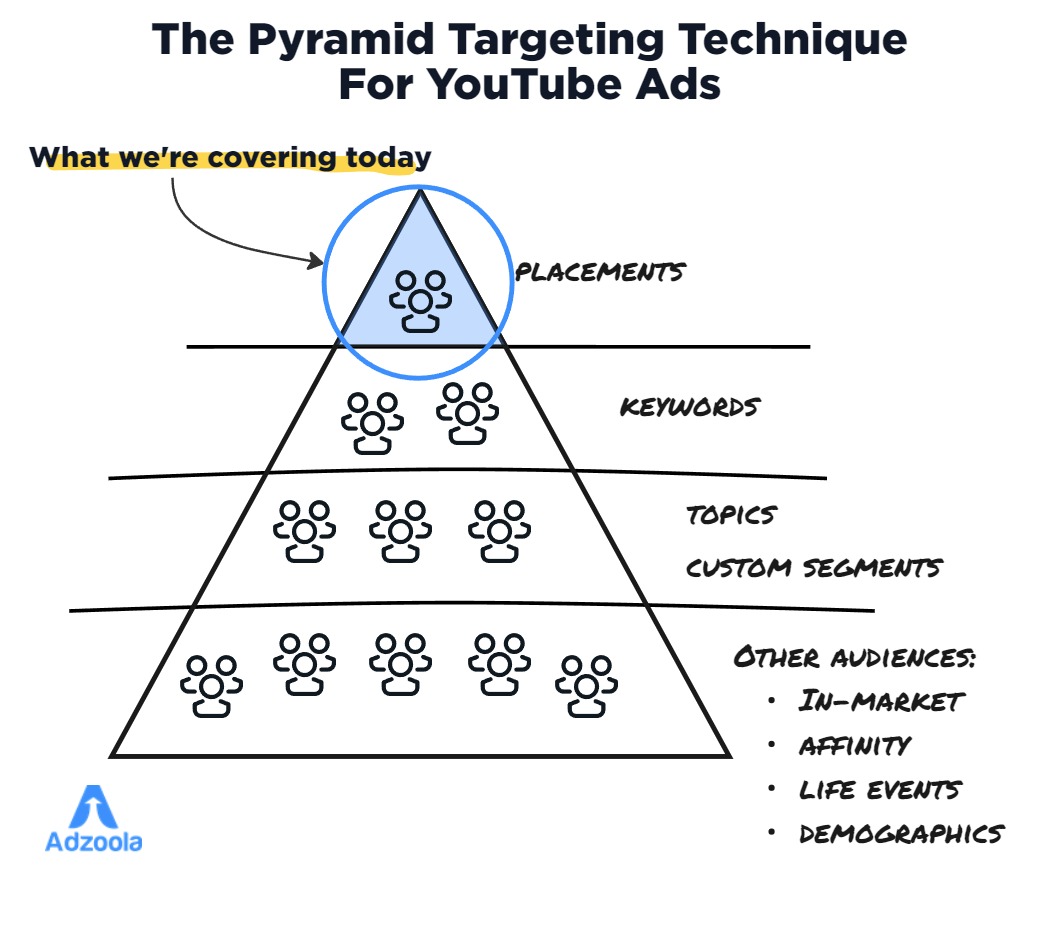
This laser-focused method allows you to hand-pick exactly where your ads will be displayed – giving you unrivaled control.
Here’s why you’ll want to start with YouTube’s placement targeting:
1. Profit-Producing ROI Potential
With tight audience targeting you’re putting your ads directly in front of a highly relevant, interested crowd. This precision-striking ability maximizes your chances of driving conversions by meeting their intent with your message.
2. Small Budget, Big Results
Since you can start with a small number of placements, placement targeting is ideal for affordably testing different ads and messages without blowing your budget. Find your winners first, then scale up (working your way down the pyramid).
3. You’re the Master of Your Audience
You choose the specific videos and channels to run your ads on, rather than relying on Google’s algorithms to figure out relevancy and serve your ads. This granular control helps ensure your ads stay hyper-focused on your prime prospects.
With such a narrow targeting method, audience sizes will naturally be smaller than broader methods like keywords, topics, custom segments and interests. But that’s the advantage – you can consistently put your brand in front of an audience you know have intent and interest at the moment you’re reaching them.
Placement Pitfalls to Avoid & Quick-Fire Tips
Placement targeting isn’t always a magic bullet. Advertisers often struggle with a few common pitfalls that sabotage their results. These will help you avoid being one of those who say “I tried, it doesn’t work” or “It won’t get conversions”.
1. Bidding Too Low
Given placement targeting is the most precise form of targeting on YouTube, it often requires higher bids to effectively compete in the auction. In practice, many advertisers pay less than their maximum bid due to the auction dynamics. Remember, you’re targeting an ultra-focused audience – it’s worth paying for that privilege.
2. Overly Restrictive Layered Targeting
Combining placement targeting with too many additional targeting restrictions, such as narrow age or geographical limits, can overly constrict the audience size and hinder performance. A light touch is often best.
3. Manual Optimization Neglect
Some advertisers struggle with high cost-per-acquisition (CPA) on placement campaigns. Often they haven’t engaged in regular manual optimizations. As it’s a manual campaign you’ve got to review and optimize regularly.
4. Misusing as a Scale Tool
While extremely powerful, placement targeting simply won’t reach the same stratospheric audience levels available on YouTube as broader methods. Use it as an intelligent testing bed and build scale with other targeting methods (further down the pyramid).
5. Keep your video and channel placements in different campaigns for easier management and optimization.
Keep your video and channel placements in different campaigns for easier management and optimization.
6. Mixing Videos and Channels
Keep your video and channel placements in different campaigns for easier management and optimization.
7. Path of Least Resistance
When starting out, it’s often easier to find well-performing individual video level placements rather than channel placements. Build from that base.
Setting Up YouTube Placements
To set up your YouTube ad campaign targeting placements, you’ll start by selecting ‘create a campaign without a Goal’s guidance’, then choose the Video campaign.

You can use placement targeting (and the other content targeting options) in four video campaign subtypes:
- Video Views – using Max CPV, Target CPV (with Multi-format ads enabled)
- Efficient Reach – using Target CPM
- Non-skippable – using Target CPM
- Audio – using Target CPM
I’d suggest starting with the Video Views Campaign (VVC) subtype if you’re running a direct-response style ad because you can use Maximum CPV (cost per view) bidding.
For in-stream skippable ads, you’ll only pay when someone watches your ad for 30 seconds or more (or watches the full video if it’s less than 30 seconds.) This is saves you money when you’re launching a new client or starting to advertise on YouTube, as it lowers your risk. You’ve chosen specific relevant videos or channels to show your ad on and you only pay when someone chooses not to skip in the first 30 seconds.
So select Video Views as the campaign subtype:

During setup it’s critical that you go to Network settings and uncheck ‘Video partners on the Google Display Network’. It’s easy to forget but it’ll cost you if you do. If you have this checked Google can (and often will) show your video ad on the Display Network, even if you only add placements to your targeting.

Scroll down and you’ll see the Content targeting options – keywords, topics and placements. Select Placements and navigate to ‘Enter’ so you can add your placements.
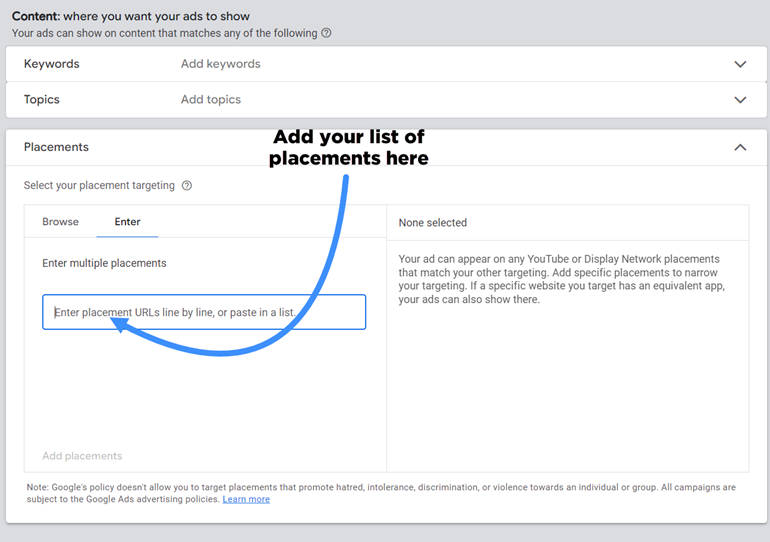
Don’t move on until you’ve actually clicked ‘Add X placements’, otherwise your placements won’t be added. I know it sounds obvious but I’ve seen cases where this has happened. It’s horrible having to tell someone they didn’t actually add the placements and the campaign has been spending that way for a while!
You can use research tools like my own, Adzoola, to find, filter and add video or channel placements to run focused campaigns to a relevant audience.
Test a handful of promising placements, analyze the results, then either maximize the winners or restart your sourcing process.

Don’t Sleep on Placements: The Low-Risk Testing Bed
For advertisers looking to maximize ROI from their YouTube ad spend – especially those operating with smaller budgets – placement targeting needs to be a core part of your strategy. The ability to put your brand and messaging in front of an ultra-relevant audience in a cost-effective manner is a game-changing advantage.
While placement targeting may require more manual management than automated campaigns, having that level of hands-on control could be the key to cracking profitable YouTube advertising for your brand and offering.
The Next Level: Scaling Up with the Pyramid
While placement targeting represents the pinnacle of precise YouTube audience targeting, it’s just the first step of a bigger picture strategy.
The Pyramid Targeting Technique is one of the frameworks I teach in my YouTube ads training course to strategically plan, manage, and scale YouTube ad campaigns. It’s designed to guide you along a path to profitable YouTube ads with less risk.
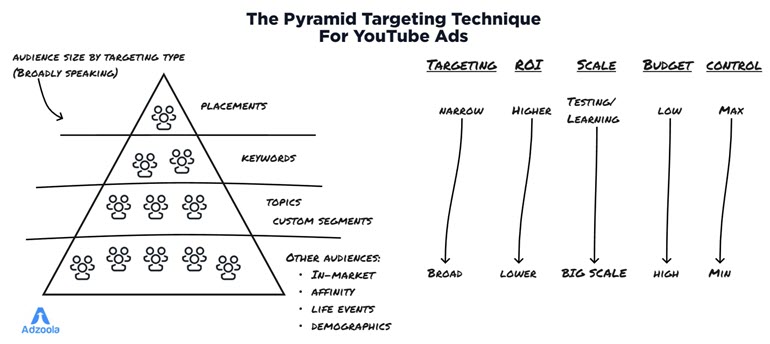
By following the Pyramid Targeting Technique and launching with focused placements, you minimize your upfront risk with lower budgets and maximum control. Once you’ve worked out your winning formula through this testing bed, you can scale your budget and expand targeting incrementally down the pyramid.
And, you can use it at almost any budget level.
If you’re a larger brand with a bigger budget and higher risk tolerance, you can skip levels of the pyramid entirely. Depending on your ability and willingness to go negative on profitability for a period, bigger players can take a more aggressive approach right away.
But for agencies, consultants and small-to-medium businesses, mastering YouTube placement targeting could be the safest and smartest first step for you.
Each successive level down the pyramid represents increased potential scale, but also becomes more hands-off and reliant on Google’s algorithms to optimize targeting. That’s why it’s so crucial for you to get your offering and messaging finely tuned and validated at the more controllable levels like placements first.
The pyramid provides you with a strategic framework to decide the appropriate starting point and level of risk based on your specific circumstances, risk tolerance and ultimate goals. The choice is yours, but this profitable, proven path is clearly mapped for you to follow.
Alex King is the founder of Adzoola and a YouTube ads specialist with over 14 years of media buying experience.
-

 PPC5 days ago
PPC5 days agoHow the TikTok Algorithm Works in 2024 (+9 Ways to Go Viral)
-

 MARKETING7 days ago
MARKETING7 days agoA Recap of Everything Marketers & Advertisers Need to Know
-

 SEO6 days ago
SEO6 days agoBlog Post Checklist: Check All Prior to Hitting “Publish”
-

 SEO4 days ago
SEO4 days agoHow to Use Keywords for SEO: The Complete Beginner’s Guide
-

 MARKETING5 days ago
MARKETING5 days agoHow To Protect Your People and Brand
-

 PPC6 days ago
PPC6 days agoHow to Craft Compelling Google Ads for eCommerce
-

 SEARCHENGINES6 days ago
SEARCHENGINES6 days agoGoogle Started Enforcing The Site Reputation Abuse Policy
-

 MARKETING4 days ago
MARKETING4 days agoThe Ultimate Guide to Email Marketing













You must be logged in to post a comment Login